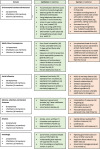"We want to live a little longer and our family want[s] us around": A summative content analysis of adherence to COVID-19-related guidelines using the Theoretical Domains Framework
- PMID: 35319141
- PMCID: PMC9111475
- DOI: 10.1111/bjhp.12591
"We want to live a little longer and our family want[s] us around": A summative content analysis of adherence to COVID-19-related guidelines using the Theoretical Domains Framework
Abstract
Objective: Public adherence to COVID-19-related government guidance varied during the initial lockdown in the UK, but the determinants of public adherence to such guidance are unclear. We capture spontaneous reflections on adherence to UK government guidance from a representative UK sample, and use the TDF to identify key determinants of COVID-related behaviours.
Design: The design was cross-sectional.
Methods: Qualitative data were collected from a large sample of UK adults (N = 2,252) via an online questionnaire as part of a wider survey about the UK public's responses to the government's COVID-19-related guidance. Summative content analysis was used to identify key guideline terms in the data, followed by latent analysis to interpret the underlying meanings behind the terms using the TDF as an analytical framework.
Results: Six TDF domains were identified in the data: Environmental Context and Resources; Beliefs about Consequences; Social Influences; Memory, Attention and Decision Processes; Emotion; and Knowledge. Although the samples were motivated and capable of adhering, limitations in their environments, resources, and social support mechanisms restricted behaviour. Self-reported adherence was sensitive to positive and negative beliefs about the effectiveness of the measures, in addition to interpretations of the terms 'essential' and 'necessary' in the guidance.
Conclusions: Despite extensive structural obstacles to adherence, the majority of the British public were able to follow government COVID-19-related instructions, provided they had sufficient resources, social support, and positive perceptions about the effectiveness of the measures. Ambiguities surrounding key terminology in the guidance left room for interpretation, which may have contributed to non-adherence.
Keywords: COVID-19; Theoretical Domains Framework; adherence; government guidance; summative content analysis.
© 2022 The Authors. British Journal of Health Psychology published by John Wiley & Sons Ltd on behalf of British Psychological Society.
Conflict of interest statement
JZL reports grants from NIHR Greater Manchester Patient Safety Translational Research Centre; CJA was supported by NIHR Manchester Biomedical Research Centre.
Figures
Similar articles
-
What challenges do UK adults face when adhering to COVID-19-related instructions? Cross-sectional survey in a representative sample.Prev Med. 2021 Jun;147:106458. doi: 10.1016/j.ypmed.2021.106458. Epub 2021 Feb 16. Prev Med. 2021. PMID: 33607123 Free PMC article.
-
Citizens' Adherence to COVID-19 Mitigation Recommendations by the Government: A 3-Country Comparative Evaluation Using Web-Based Cross-Sectional Survey Data.J Med Internet Res. 2020 Aug 11;22(8):e20634. doi: 10.2196/20634. J Med Internet Res. 2020. PMID: 32716896 Free PMC article.
-
A Qualitative Study Evaluating the Factors Affecting Families' Adherence to the First COVID-19 Lockdown in England Using the COM-B Model and TDF.Int J Environ Res Public Health. 2022 Jun 14;19(12):7305. doi: 10.3390/ijerph19127305. Int J Environ Res Public Health. 2022. PMID: 35742548 Free PMC article.
-
Mapping modifiable determinants of medication adherence in bipolar disorder (BD) to the theoretical domains framework (TDF): a systematic review.Psychol Med. 2021 May;51(7):1082-1098. doi: 10.1017/S0033291721001446. Epub 2021 May 19. Psychol Med. 2021. PMID: 34006337 Free PMC article.
-
Reducing catheter-associated urinary tract infections: a systematic review of barriers and facilitators and strategic behavioural analysis of interventions.Implement Sci. 2020 Jul 6;15(1):44. doi: 10.1186/s13012-020-01001-2. Implement Sci. 2020. PMID: 32624002 Free PMC article.
Cited by
-
Effectiveness of communications in enhancing adherence to public health behavioural interventions: a COVID-19 evidence review.Philos Trans A Math Phys Eng Sci. 2023 Oct 9;381(2257):20230129. doi: 10.1098/rsta.2023.0129. Epub 2023 Aug 23. Philos Trans A Math Phys Eng Sci. 2023. PMID: 37611630 Free PMC article. Review.
References
-
- Atchison, C. , Bowman, L. R. , Vrinten, C. , Redd, R. , Pristerà, P. , Eaton, J. , & Ward, H. (2021). Early perceptions and behavioural responses during the COVID‐19 pandemic: a cross‐sectional survey of UK adults. British Medical Journal Open, 11(1), e043577. 10.1136/bmjopen-2020-043577 - DOI - PMC - PubMed
-
- Beeckman, M. , De Paepe, A. , Van Alboom, M. , Maes, S. , Wauters, A. , Baert, F. , … Poppe, L. (2020). Adherence to the physical distancing measures during the COVID‐19 pandemic: A HAPA‐based perspective. Applied Psychology: Health and Well‐Being, 12(4), 1224–1243. 10.1111/aphw.12242 - DOI - PubMed
-
- Benham, J. L. , Lang, R. , Kovacs Burns, K. , MacKean, G. , Léveillé, T. , McCormack, B. , … Marshall, D. A. (2021). Attitudes, current behaviours and barriers to public health measures that reduce COVID‐19 transmission: A qualitative study to inform public health messaging. PLoS One, 16, e0246941. 10.1371/journal.pone.0246941 - DOI - PMC - PubMed
Publication types
MeSH terms
Grants and funding
LinkOut - more resources
Full Text Sources
Medical


